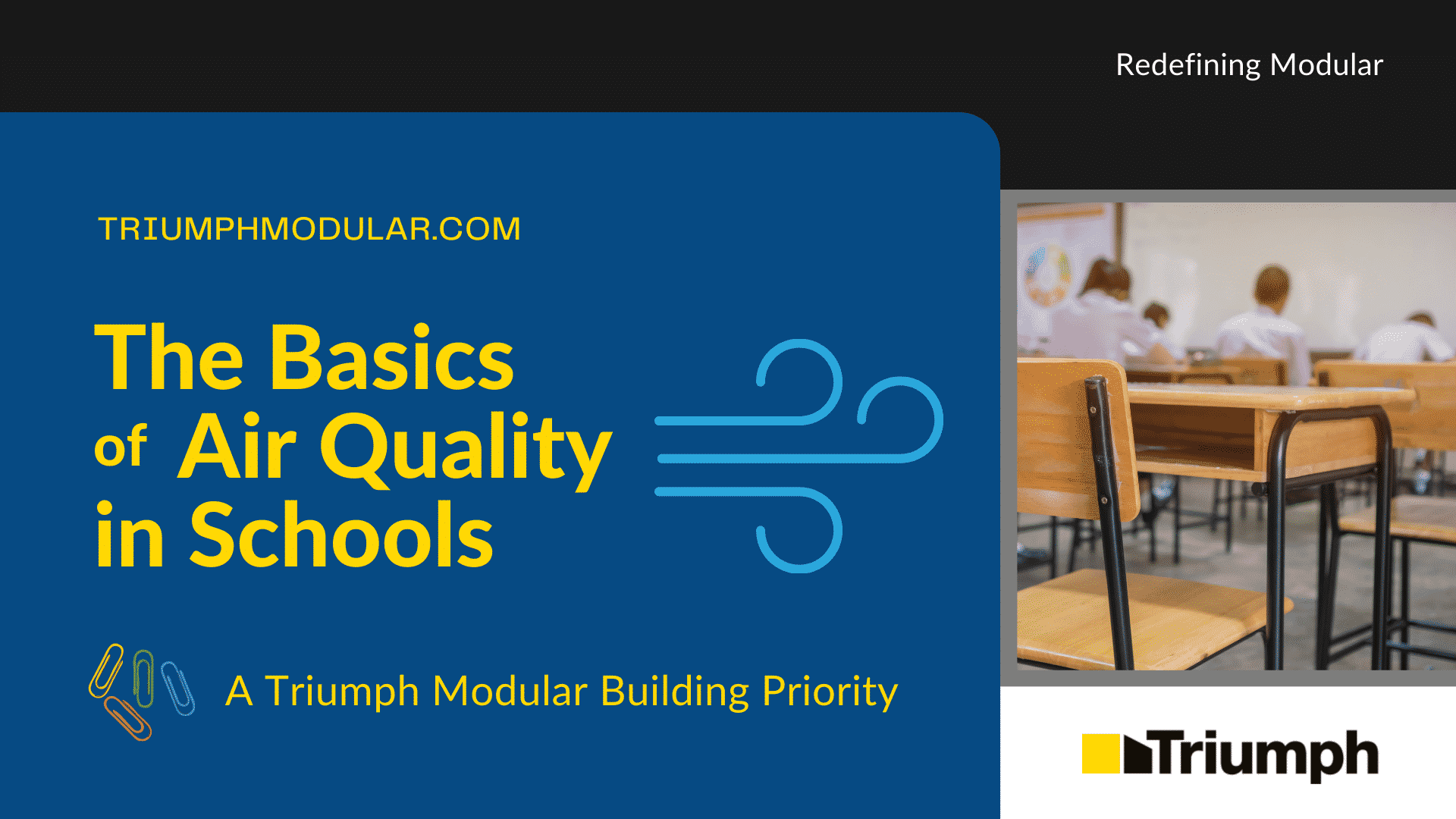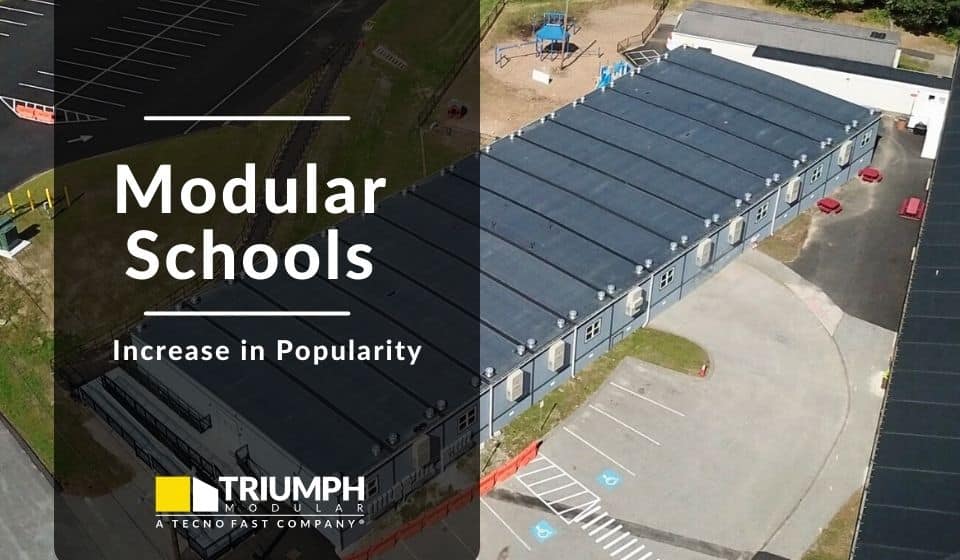All schools should be providing students with the best chance of learning and succeeding in various endeavors.
This means hiring experienced and inspiring teachers. Keeping a neat and tidy environment. Crafting curriculums and programs that are tailored to student needs.
But what about indoor air quality?
With students spending several hours a day in school, the importance of a healthy learning space cannot be understated. At Triumph, we take air quality seriously in our modular buildings.
This is why it’s important to know about the basics of indoor air quality.
Thankfully, this article will teach you all about indoor air quality, how it affects schools and occupants, and even some strategies for improving air quality.
What Causes Poor Indoor Air Quality?
With how important indoor air quality is for schools and creating a positive learning environment, it’s important to know the key contributors to poor indoor air quality.
Indoor pollutant sources
There are a variety of different pollutants that can reduce indoor air quality in a school. Some of these include:
- Excess moisture (which can cause mold)
- Cleaning products
- Fumes from different newly-installed flooring
- Central heating systems
- Cooling systems
- Humidifiers
How big of an effect each of these pollutants can have on occupants depends on how prominent it is in the air. It’s also worth noting that some pollutants are a constant, such as carpet fumes or pressed wood from furniture, while others are only prominent when they’re in use, such as cleaning products.
Poor ventilation
Pollutants can take over when ventilation isn’t adequate enough. This is because ventilation, whether mechanical or natural, helps to cycle in fresh air from the outdoors and remove some of the pollutants that develop indoors.
Allowing these pollutants to accumulate due to poor ventilation can lead to various health risks for students and staff.
The Adverse Effects of Poor Indoor Air Quality
The effects of poor indoor air quality on building occupants can be divided into two separate categories:
- Immediate
- Long-term
Immediate health effects
Poor indoor air quality can have some immediate effects on school occupants. This could be due to single exposure or even repeated exposures. While these effects are usually manageable and short-term, they still have a negative effect on the overall space. Typically, these effects are treatable by leaving the polluted area or eliminating the source of the pollution.
Some common immediate effects caused by exposure to pollutants include:
- Irritation to the eyes, nose, and throat
- Dizziness
- Fatigue
- Headaches
Immediate adverse health effects may only show in people with pre-existing medical conditions. Others may be affected regardless of any ailments. The effects vary depending on the person.
Long-term health effects
This is where poor indoor air quality can be scary. Should someone be exposed to certain pollutants for an extended period of time, long-term health effects can present themselves.
Some of the more prominent ones include:
- Respiratory diseases
- Heart disease
- Cancer
The worst part is that if you aren’t aware that you’re exposed to these pollutants, you may develop these long-term effects without even knowing. The length of exposure to develop any of these ailments will likely depend on both the person and the pollutant in question, making it even more unpredictable.
How to Improve Indoor Air Quality
Considering the detrimental effects of poor indoor air quality, the question remains: How can you improve indoor air quality in schools?
There are a few different routes you can take to maximize air quality throughout a school. Here are a few of the most common strategies:
Removing the pollutants themselves
It seems obvious enough, but the best way to improve indoor air quality is to eliminate the pollutants at the source. While it might seem easier to simply improve your ventilation, it isn’t nearly as cost-effective as eliminating the pollutants themselves.
Cleaning products, for example, should be properly stored when not in use to avoid leakage problems.
Increasing ventilation
There are three primary ways that outdoor air comes into a building:
- Mechanical ventilation
- Natural ventilation
- Infiltration
Mechanical ventilation involves outdoor air intake using heating systems and air conditioning systems. This is common in most commercial buildings to cycle in more outdoor air.
Adequate HVAC is an essential component of maintaining quality air throughout the school. Without an appropriate system for recycling air, students and staff will likely experience many of the adverse effects associated with poor indoor air quality.
Take Triumph’s Silverline Series buildings, for example. The single-wide Silverline building is able to completely recycle air within 30 minutes thanks to increased ventilation throughout the space.
Natural ventilation is essentially cycling outdoor air into the school through open windows and doors. By using natural ventilation, you can reduce the potency of pollutants inside the building.
Infiltration is when outdoor air flows into the space through various openings in the space. Some of which include:
- Joints
- Cracks in the walls
- Openings in the floor and ceiling
- Cracks near windows and doors
This process occurs in nearly any space, especially residential homes.
Using air cleaners
Different types of air cleaners can be used to improve indoor air quality throughout a school. However, it’s important to note that there are many different types, ranging from inexpensive, single room-focused models to larger space air cleaners designed to clean up the entire house.
When it comes down to it, air cleaner functionality has two main aspects:
- Collecting the pollutants themselves
- Drawing air through a cleaning element or a filter
An effective air cleaner will be able to perform both of these tasks effectively. Pollutant collection without proper air circulation will be ineffective, and vice-versa.
The potency of the pollutant is also a factor in determining the effectiveness of any given air cleaner. For example, in some cases, a pollutant may be too strong for a simple table-top air cleaner to handle. A more sophisticated and powerful air cleaner might be necessary to ensure quality indoor air.
Air cleaners should be used in tandem with other methods of improving indoor air quality for the best results.
Conclusion
Keeping pristine indoor air quality should be a priority when it comes to managing schools.
Not only can poor indoor air quality irritate the senses and make learning and work difficult due to a polluted environment, but it can also cause serious long-term health effects.
By keeping informed and employing the strategies mentioned above to clean up indoor air, you can stay on top of your school’s air quality situation and ensure that your students have a healthy learning space.
Looking for More Information?
Triumph’s modular school offerings are designed with pristine indoor air quality near the top of our priority list. Because of this, we have a confident grasp of how indoor air quality can be improved and the effects it can have on students and staff. We also have a previous blog post that highlights air quality topics for schools from an important EPA report on air quality. If you’re looking for more information on indoor air quality, don’t hesitate to contact us. We’re here to help.




